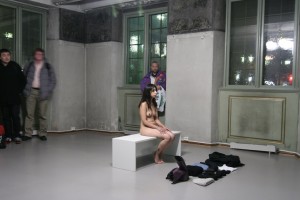« Features
Bodily (Re)Marks: The Performance Art of Regina José Galindo

Regina José Galindo. Tumba, 2009. Video Oscar Oviedo and David Pérez Karmadavis. Photo: Oscar Oviedo. Courtesy of the artist and Prometeo Gallery di Ida Pisani.
By Maja Horn
Recently, I had the opportunity to coincide again with the renowned Guatemalan performance artist and poet Regina J. Galindo (1974) at the international performance event “Performar” (www.performar.blogspot.com) in the Dominican Republic, organized by the collective Arte-Estudio and the Centro Cultural de España. We had both lived for extended periods of time in the Dominican Republic in 2005-2006, when Regina J. Galindo had just received the young artist award at the Venice Biennial, and I was coordinating and teaching a performance studies program at FLACSO (Facultad Latinoamericana de Ciencias Sociales). I was thus a firsthand witness to how her presence in the Dominican Republic during this time was extraordinarily invigorating for the burgeoning Dominican performance art scene and how she made incisive contributions to it. Both professionally and personally Regina J. Galindo developed strong ties to the Dominican Republic and tellingly, not only one of her performance pieces is named Isla (Island) but so is also her now two-year old daughter, with her Dominican partner, performance artist David Pérez (”Karmadavis”).
After a three-year lapse, I was thus particularly excited about Regina J. Galindo’s return from Guatemala to the Dominican Republic for a performance event that asked its participants to reflect on the relation between performance and “el mar,” the ocean that inevitably demarcates and conditions experiences of Caribbean insularity. For her piece, entitled Tumba, Regina J. Galindo contracted several local Dominican men who, from a small boat and at a visible distance from the shore, dropped several large suitcases-large enough to fit a human body-into the ocean one after another. The scene eerily restaged how unwanted Caribbean bodies are easily disappeared into this bottomless grave without a trace. While Tumba strongly tapped into contemporary Caribbean reality and the effects of various forms of criminality and trafficking, whether related to illegal substances or humans, this scene also bespoke of a long Caribbean history of disappeared bodies reaching all the way back to the notorious slave-holding vessels whose paths were littered with dead and forever invisibly submerged bodies.

Regina José Galindo. Himenoplastia, 2004. Video 7' 2". Photo: Bella de Vico. Courtesy of the artist and Prometeo Gallery di Ida Pisani.
Tumba resonates with Regina J. Galindo’s substantial body of performance art work but also gestures towards new directions emerging in her artistic trajectory. While most of her previous performance works relied on her own body as the main expressive vessel, here the artist herself was not present. And, unlike many of her earlier pieces that spoke starkly to the violent conditions in her home country, Guatemala, Tumba responded to the particular cultural and socio-political Caribbean context where it took place. Indeed, several of her recent performance projects respond much more directly to the local context in which they unfold, including Warm Up (England, 2009), Let’s Rodeo (U.S., 2008), America’s Family Prison (U.S., 2008) and Rompiendo el hielo (Norway, 2008). [1]
While Tumba is indicative of this more recent tendency in Galindo’s work, it also reflects precisely the complex ways in which bodily presences and absences are evoked in some of her most renowned past pieces. Her performance (279) Golpes, that formed part of the 2005 Venice Biennial, consisted of a closed cubicle in which the artist hit herself once for each of the women (279 total) killed so far in Guatemala that year. The sound of these “golpes” was amplified to the outside for the audience. As in Tumba, this piece speaks loudly of victimized bodies whose deaths are never officially accounted for; their absence is made tenable and “present” not through rendering these hyper-visible, as the media like to do, but rather through a precise evocation of their absence: the unseen bodies in the suitcases, the disappeared bodies of killed women. The artist’s own body functions here as a tool to voice the human costs of these larger social tragedies, and, at the service of these denunciations, her body certainly does often become hyper-visible and starkly present in many of her other works; this includes for example the video that accompanied her Venice Biennial performance, Himenoplastia, in which it is graphically shown how the artist undergoes an illegal surgery to reconstruct her hymen, i.e. her virginity, a performance that would help her win the prestigious “León de Oro” prize awarded to emerging young artists.
There is, of course, a venerable history of performance artists pushing their bodily limits, Chris Burden inevitably comes to mind, and various women performance artists such as Linda Montano, Marina Abramovic, and Orlan. The latter, a French performance artist, for example, staged colossal performance events around her undergoing plastic surgeries in the early 1990s that resulted in videos that were too bloody and gruesome for many viewers to watch. Yet, while Regina J. Galindo’s work is clearly informed by her predecessors in the performance art world, her work lacks their often autobiographical dimensions. Even though Regina J. Galindos’ pieces implicate her in the most personal ways, they are not about her. Sure, she speaks of violence and political oppression in Guatemala, of its gendered effects, both conditions that affect her too, but she does not make her own identity her site of enunciation, and one may call her performances “post-identitarian” in this sense.

Regina José Galindo. Rompiendo el Hielo, 2008. Still Video, 23' 22" Du store verden!/the DSV network. Courtesy of the artist and Prometeo Gallery di Ida Pisani.
But it is not only the relation between her own body and her performance pieces, but also the relation between these and the audience that I find differ from what one may perceive as her predecessors in the performance art world. Both renowned performance pieces by Yoko Ono, Cut Piece (1964), and Marina Abramovic, Rhythm O (1974), demanded audience interventions on the artists’ bodies. In the case of Yoko Ono, audience members were provided with a pair of scissors to cut off her clothes, and Abramovic placed herself with various objects in a gallery, including a gun, that were at the disposal of the audience. Both pieces brought out the worst in some audience members, who reacted with what many saw as a disturbing aggressiveness towards these women’s bodies. One of Regina J. Galindo’s recent performances offers an interesting contrast to these two works: in her piece Rompiendo el hielo (2008), she sat naked in a very cold room in Oslo, Norway, in front of her a pile of clothes waiting for the audience to dress her to protect her from the cold, which they indeed proceeded to do. While Galindo’s work is starkly critical and denunciatory, she does not eye or implicate the audience with suspicion. This piece is indeed a rare example of her directly engaging the audience and crossing in this way the boundary between art and “reality.”
Both how she employs her own body as a self-conscious tool (but not as a personal referent), and the way she presents her works to the audience are not at the service of pushing the boundaries between art and life/reality, as performance art has often claimed to do. These performance art pieces are unequivocally presented as works of art, works that have much to say about reality and its critical political, social and cultural dimensions, but that does not endeavor to erase their boundaries. The question “Is it art or is it life?” that some performances like to put forward to their audiences is a self-reflexive exercise about the very nature of art that Galindo is not interested in asking, nor do most Latin(o) American performance artists according to the curators of the Museo del Barrios’ seminal exhibit “Arte ? Vida” (2008), a retrospective of four decades of Latin(o) American performance art work. As the museum’s director of curatorial programs explains, “[t]he title of this project … troubles the commonplace idea that art is equivalent to life, and life is art. What is proposed through these many works is that while art affirms and celebrates life with a regenerative force, and sharpens and provokes our critical senses, artistic actions that address inequalities and conflict are not equivalent to real life endured under actual repression”.[2] Galindo’s work does not indulge in such confusions and in this sense aligns with the works of her Latin American peers; however, what makes Galindo’s work stand out among other Latin American performance artists at a fairly young age, and for which rightfully she is considered one of the most important contemporary Latin American artists, is the consistency of her conceptual and aesthetic language. [3]

Regina José Galindo. America’s Family Prison, 2008. Commissioned and produced by ArtPace. San Antonio, Texas. Photo: Todd Johnson. Courtesy of the artist and Prometeo Gallery di Ida Pisani
Unlike some of the more “baroque” tendencies in Latin American performance art, which involve multiple objects or are elaborately staged events, she pares her performances down to their essential ingredients through a careful development and editing process that reflects her experience and skills in another creative form - poetry. Galindo is a well-published poet, and she in fact started out as a writer before turning more insistently to performance art. It would be reductive to apprehend her performance art work mainly through the lens of poetic practice, but what stands out in her work, and what has allowed her to push so-called “body art” to new levels, is how she employs her body consciously as a cipher. Rather than laying claim to personal bodily experience or insisting on the supposed unintelligibility of the body (as many more autobiographical performance art works do), she taps into the body as a starkly coded social, cultural and political signifier within a larger system of signs. Her performances draw from and maximize this signifying function of the body, and while in many cases her own slight female Guatemalan body might be the most effective expressive vehicle, in other cases, as in Tumba (but also in Ablución, 2007), she strategically employs other bodies as more apt signifiers to throw a wrench into troubling dominant social, cultural and political discourses to ask not if art is life, but why life remains unlivable for so many.
Notes
1- All featured at www.reginajosegalindo.com
2- Arte ? Vida: Actions by Artists of the Americas 1960-2000, ed. Deborah Cullen, New York, El Museo del Barrio, 2008, p.12
3- She figures for example among the one hundred Latin American artists mentioned in the book 100 Latin American Artists, Madrid, Exit Publications, 2007.
Maja Horn: MA in Performance Studies (New York University), PhD in Romance Studies (Cornell University). Assistant Professor in Spanish and Latin American Cultures at Barnard College, New York.


































